Everything you must know about Lisbon cruise port: where is Lisbon and the terminals where cruise ships dock, things to do, how to get around and explore on your own, what's within walking distance, what's beyond the historical center, dining, and more ...
Lisbon is a charming city, buzzing with life, with a rich history and beautiful attractions to explore. Lisbon exudes beauty through its sublime natural setting, a culture of warmth, and friendly residents.
Contents
- Overview
- Where is Lisbon
- Where cruise ships dock
- How to explore Lisbon on a cruise
- Top things to do and see
- How to get around
- Explore Lisbon on Your Own
- What's within walking distance
- What's beyond the Historical Downtown
- Dining and local food
- Good to know: language, currency, opening hours
Overview
Lisbon's atmosphere is a harmonious blend of antique and modern, where ancient cathedrals tower over a cosmopolitan way of life. Being the westernmost city in Continental Europe, only in the last 6 years Lisbon was discovered by the cruise lines that sail the south european atlantic shores.
Just before the Covid Pandemic upended cruising, a new cruise terminal a stone's throw away from the historical center. As ships return to the port of Lisbon, waves of cruise passengers are inundating the city's heart and the many destinations close to the city such as Sintra, Óbidos and the Sanctuary in Fátima.
Where is Lisbon and the cruise port
The cruise port of Lisbon, the capital of Portugal (with a population of around 545,245), is located in the Southern European Atlantic region. The city is on the estuary of the River Tagus as it flows into the Atlantic Ocean, 173 miles (277 km) south of Porto and 608 miles (979 km) northeast of Funchal (Madeira).
Where cruise ships dock in Lisbon
Depending on the tides and the number of ships visiting Lisbon, your cruise ship may dock in two different quays. The official names of the two cruise docks in the port of Lisbon are a mouthful, so most savvy cruisers refer to these as the Old Terminal and the New Terminal.
Both docks are on the north bank of the estuary of the River Tagus (Tejo, in Portuguese), the longest river in the Iberian Peninsula.
If you have the opportunity to be out and about as the cruise ship arrives in port do not miss it. But if you miss the arrival, make sure to be out on deck when the ship sails away. Passing under the bridge is great fun and the views of the city from the river are really sensational.
Gare Marítima da Rocha Conde de Óbidos
The old cruise terminal is officialy named Gare Marítima da Rocha Conde de Óbidos. It is close to one of the widest bridges in Europe with a striking resemblance to the Golden Gate Bridge.
This cruise terminal is not far from the Historical Downtown (known by locals as Baixa) but a little too far to walk. It is a 10-minute drive but over 30-minute walk
.Most cruise lines provide a complimentary shuttle bus or at a reasonable cost, and a taxi ride would cost around US$10.00. The shuttle bus drop-off is usually close by the Terreiro do Paço, the large main square in Baixa facing the river.
The new Lisbon cruise terminal
The new cruise terminal, inaugurated in November 2017, is on a one-mile-long pier. It is within walking distance to the Historic Downtown District (Baixa, in Portuguese).
This quay has been operational for a long time with a smaller but very functional cruise terminal officially named Santa Apolónia Cruise Terminal. The latter has now been integrated into the long pier and managed by the new Lisbon Cruise Terminal.
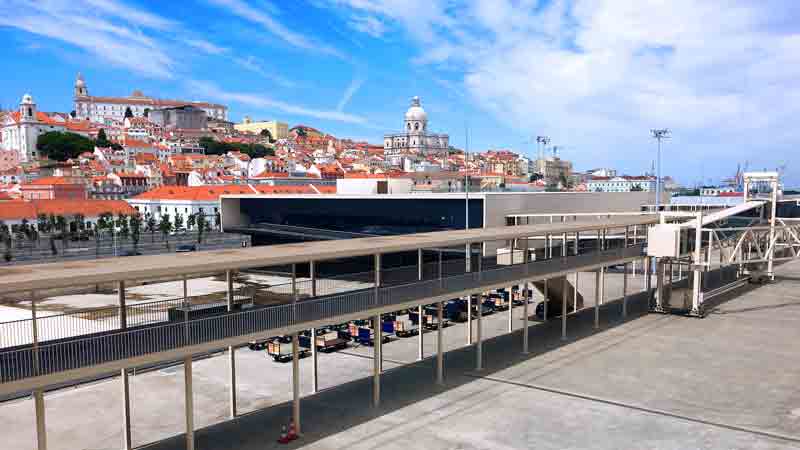
The new cruise terminal in Lisbon port
Photo © IQCruising
Santa Apolónia Cruise Terminal is the farthest from downtown - 0.9 miles (1.4 km) to Terreiro do Paço (aka Praça do Comércio) square. The recently built Lisbon Cruise Terminal has larger spaces, better services, and amenities and is closer to downtown - 0.6 miles (900 meters) to Terreiro do Paço square. This is where most large ships dock when calling at the cruise port of Lisbon.
However, when more than a couple of large cruise ships are docked in the new Lisbon Cruise Terminal it can get a bit chaotic and it may take more than 15- minutes just to exit the pier, walk through the terminal building, the flood of Tuk-Tuk Drivers, Taxis, City Sightseeing buses and all sorts of local tour operators offering their services.
How to explore Lisbon on a cruise
Whatever you choose to do or see in Lisbon, it is easy and affordable to explore the city. Naturally, if the cruise passenger wishes to visit attractions outside the historical center, it is advisable to book a cruise excursion or a tour with local operators.
But there are many interesting, fun, and enjoyable things to do in Lisbon on your own. However, cruise passengers with walking difficulties must be aware that Lisbon is not the most comfortable city to explore beyond the downtown area, which is the only flat area in the city.
Although Lisbon always requires a bit of uphill walking, the best way of exploring the city is on foot. Or with the 100s of Tuk-Tuk buzzying around. You can also choose to use one of the many Hop-On Hop-Off sightseeing buses or get on a Tourist Tram to meander the hills of Lisbon.
Cruise passengers who wish to visit attractions in the outskirts of the city, will be surprised with how taxis and Uber are so affordable. Put simply, here are our five recomended ways to discover Lisbon on a cruise ship:
- Shore excursions or local tours
- On Foot
- Tuk-Tuk Cars
- Hop-On Hop-Off Sightseeing
- Taxi - Uber - Lift
Top things to do and see
The cruise traveler has a lot to choose from when calling at the port of Lisbon. Top highlights of Lisbon for cruise travelers include the Belém's UNESCO sites, Sintra's Romantic Castle, the Sanctuary in Fátima or the medieval walled town of Óbidos.
But you can also choose to enjoy a leisurely day walking around the old downtown district known as 'Baixa', strolling up the tree-lined Avenida da Liberdade, stop for a warm custard tart in one of the city’s patisseries, marvel at stunning urban scenery from the Castelo de Sao Jorge, or lunch al fresco in the quaint Bairro Alto.
You will have the opportunity to venture at your own pace into century-old castles and discover the intricacies of Portugal’s own Manueline style. Sample traditional flavors and indulge in local delicacies such as Bacalhau (the national dish). Whatever you choose to see, go slow and take it all in. Lisbon is best experienced in sync with its laid-back pace, enjoying sun-filled days that melt into festive nights.
Regardless of where your cruise ship docks, Terreiro do Paço square should always be your main point of reference. Standing on this large square with your back to river, you will see the castle to your right hand side.
The São Jorge (Saint Jorge) castle is the most visited landmark in Lisbon but we find it overrated. However, to get to the castle you will pass by beautiful churches and, you must not miss the Sé (Lisbon Cathedral).
Behind the Terreiro do Paço square, is the Baixa (downtown), which is a joy to walk. To the left side of the baixa are the Chiado and Bairro Alto districts, where you will breath the romantic athmosphere of the city.
The Belém distric is famous for it's historical connection with the days when the portuguese navigators roamed the seven seas to reach India and Japan, and discovered Brazil.
In Belém, you will find 2 UNESCO heritage sites, and the 8 mile journey is worth every single second.
Belém is on the west limits of the city, and to the oppposite side is a district known as Expo. Here you will find a huge Oceanarium and the largest Casino in Europe. Here are the most interesting areas to explore within the city of Lisbon:
- Baixa, downtown district
- Castelo de Sao Jorge
- Sé, the Lisbon Cathedral
- Chiado and Bairro Alto districts
- Belém's UNESCO sites
- Oceanarium and Expo district
Outside Lisbon, and relatively close by, the romantic town of Sintra has a few royal palaces and the ruins of a moor castle to visit.
Estoril and Cascais are two beautiful resort towns also close by. Around half hour north of Lisbon, Mafra Convent is stunning site to visit but that cruise lines ignore.
By contrast, all cruise lines offer shore excursions to the medieval town of Óbidos and to the Fátima Sanctuary. Tomar and Évora are two other historical cities ignored by cruise line's shore excursions. Both are UNESCO heritage cities, which can be visited with local guides. Here are the most interesting sites to explore beyond the city of Lisbon:
- Sintra palaces and castle
- Estoril-Cascais, resort towns
- Mafra Convent
- Óbidos, medieval walled town
- Fátima Sanctuary
- Évora, UNESCO city
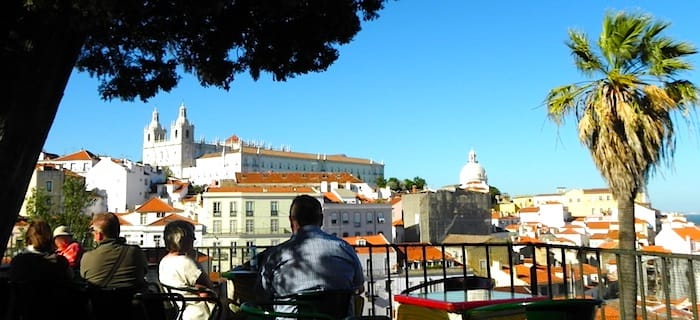
Miradouro St Luzia
Photo by IQCruising.com
How to get around
As mentioned before, Lisbon is a very easy city to explore. Besides an excellent public transportation network, there are lots of different services offering all sorts of tours.
- City Sightseeing
- Gray Line, sightseeing
- Yellow Bus, sightseeing
- Go Car Tours
- Tuk-Tuk Cars
- Taxis and Uber
- Public Buses
- Trams
- Subway
Sightseeing, Bus, Cars and Tuk-Tuk
For those that like sightseeing, Lisbon has a wide choice. There are three different Hop-on Hop-Off bus companies - City Sightseeing, Gray Line , and Yellow Bus. There are also a couple of unusual and fun ways of sightseeing; a self-guided electrical car for two - Go Car Tours -, and what has become a very popular way of getting around the city - Tuk-Tuk Cars. The latter is an upgraded and Eco-friendlier version of the ones found in India.
Taxis and Uber
Taxis are affordable in Lisbon, you find them by all major sites and by the terminal. All taxis are metered, drivers tend to speak English but, like in any big city, make sure you get an estimate before getting into a taxi, as you should not pay more than $10.00 US Dollars (8 Euros) to go anywhere within the historical city center.
In the last couple of years Uber has become available in Lisbon. Prices are very competitive specially considering that the amount paid is converted at the day's rate without any commission fees. However be aware that at pick and rush hours the Uber fares can be more expensive than a regular taxi.
Public Buses and Trams
Public Buses are not particularly easy to navigate or useful for the cruise traveler but the Trams have good connections to major tourist attractions and can be particularly useful for those wishing to explore Belém. Click Here to Check the Official Website in English.
Be aware that same of the Routes are famous Touristic Tours - like the Red Train ride up to the Castle and not only are expensive as these can get very, very crowded.
Cruise Tip: stick to the real stuff, meaning the public yellow trams. However, so many tourist have discovered the affordability of public trams that these are Usually packed, you guessed it, by tourists.
Metro - Subway - Underground
Known by locals as 'Metro' the underground is the lesser used transportation by cruise travelers and tourist alike but is very easy to navigate, affordable and has stops next to many highlights.
If docking at Santa Apolónia there is an underground stop right next to the exit of the terminal. Click Here to check the official website in English.
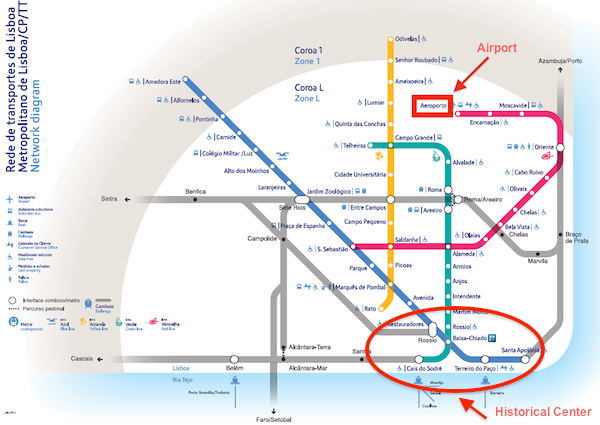
Car Rental
Renting a car is an option we would not advise. The traffic in Lisbon can be chaotic, parking is very limited, the traffic signs can be misleading and you may find yourself wasting hours looking for directions.
Explore Lisbon on Your Own
Either sailing into the River Tejo or away from Lisbon, you will see that the Great Metropolitan Area of Lisbon occupies the sloping hills rising from the north bank of the river and along the Atlantic Coast. But the core of the city is really much smaller. After all, in this capital with close to 3 million inhabitants in its metropolitan area, only less than 600,000 live in the city itself.
Within walking distance - the Historical Downtown
As mentioned before, the Terreiro do Paço square (aka Praça do Comércio) is either withim wlaking distance if you are docked at the new cruise terminal, or the drop-off stop of the shuttle bus. the Terreiro do Paço is in itself a landmark not to be missed, and within walking distance you will find the following:
- Terreiro do Paço (Praça do Comércio)
- Rossio square
- Praça da Figueira (square)
- Chiado district
- Bairro Alto
- Igreja de S. Roque
- St Justa Elevator
- Elevator da Gloria
Terreiro do Paço, the majestic square by the river has been embracing visitors to the city for centuries and is the ideal place to start a tour of Lisbon. Here you will find a Tourist Office, the stops for Sightseeing Tour Buses and for the Historical Trams that will take you up and downhill through narrow streets for a memorable 45-minute ride.
The statue of King Joseph I on horseback stands in the middle of the square as a guardian of the city. During his reign, Lisbon was hit by a devastating earthquake, in 1755. The earthquake was followed by a tsunami and a fire, which destroyed most of the city and the old Royal Palace that once stood on the Terreiro do Paço.
Under the supervision of the King’s Prime minister (the Marques de Pombal) the square was renamed Praça do Comércio. All area behind this square was rebuilt as a grid of 48 streets ending in two other squares: the Rossio square (with its beautiful fountains, the National Theatre and a majestic column in the center) and Praça da Figueira a less elegant square but with a great view of the Castle.
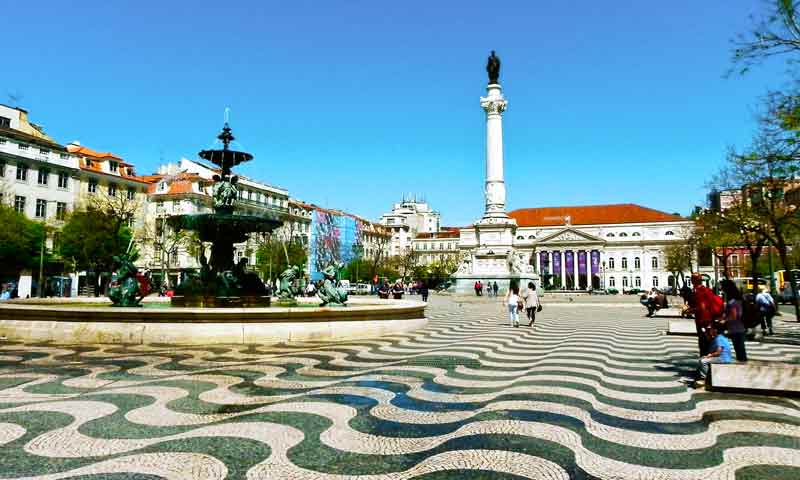
Rossio Square
Photo © IQCruising
The Baixa (downtown in Portiguese) used to be the main shopping district of Lisbon, but as the city expanded it is now on the way uphill to Bairro Alto that you will find the best of high-end shops
Reaching Largo do Chiado it becomes obvious why the outdoor sitting of two coffee shops become so popular. These are ideal fro cruise travelers to have a rest, before venturing up to visit the Igreja de S. Roque one of the most interesting churches in Lisbon. After this church, don’t miss the view from Miradouro de S. Pedro de Alcantara.
From here you can take the Elevator da Gloria to go down to Restauradores or walk back. Another tip: instead of walking up to Chiado, take the elevator up and then walk down.
To the right of Terreiro do Paço you can see the castle towering above the entire city. The walk to the castle (St George's Castle) is steep at times. The best way for cruise travelers to explore the castle district is to take the tram up as close as possible to the castle and then walk down to visit the church of S. Vicente de Fora and the Lisbon Cathedral.
You can then venture through the narrow streets behind the cathedral to explore Alfama, Lisbon’s medieval working-class district. And if you feel like a stop before heading back to the ship, the Martinho da Arcada, oldest café in town is the place to go in Terreiro do Paço.
What's beyond the Historical Downtown
The western border of the Lisbon, known as Belém, is the site from where the Portuguese navigators departed to explore the seven seas in the 15th and 16th centuries. Here you will find two UNESCO Heritage sites in Lisbon: the Tower of Belém and the Mosteiro dos Jerónimos both built in the 16th century to commemorate the glorious days when Vasco Da Gama sailed to India and Cabral discovered Brazil.
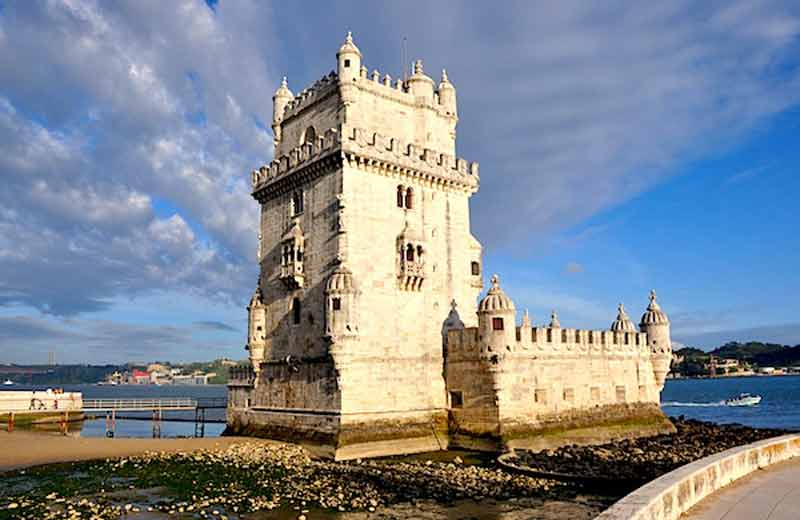
Belém Tower in Lisbon
Photo © IQCruising
In Belém you will find as well another monument to these explorers built in the 1960’s, the Padrão dos Descobrimentos, the new Cultural Center of Lisbon and the most visited museum in Lisbon: the Museu dos Coches with an amazing display of old Carriages. With so much to see in Belém, visiting this area can take more than half-day.
The Museum of Art Antiga – the Ancient Art Museum – is also worthwhile visiting. Hieronymus Bosh, Zurbaran, and Portuguese medieval painting are the highlights. By the way, if docking in Cais de Alcantara this museum is within walking distance.
The walk up Avenida da Liberdade to Marques de Pombal and then to the top of the Parque Eduardo Sétimo (Edward VII Park) is a long stretch and only worthwhile to see a fantastic panoramic view of Lisbon.
Most sightseeing buses stop at the top of this park and there is no reason to walk all the way up to this viewpoint. If planning to go that far, we suggest a visit to the Gulbenkian Museum with its collection of Lalique jewelry, Egyptian and Persian Art.
The Oceanário is one of the largest aquariums in the World and because it is in the East extreme of the city will take an entire morning to visit including traveling time.
Dining and Local Flavors
Unless you are looking for a gourmet cuisine, you will find that even those restaurants that look like “tourist traps” serve fresh, simple and tasty food, in lovely outdoor settings.
Almost every single restaurant will offer fresh seafood and the most popular Portuguese fishes - Sardines and Bacalhau – this one cooked in an incredible variety of ways.
Don’t expect to find tapas, light meals, salads or filling sandwiches. So, if all you want is a snack you are better off by sitting in a Pastelaria or a Coffee Shop and order one of the many pastries on display – the famous Pastel de Nata is simply delicious. "Empanadas", meat croquets, and the shrimp rissole are the best snacks to taste in Lisbon.
A tip on wine: Although Portugal is a producer of good wine, restaurants do not offer house wine at reasonable prices. The wine list starts with bottles at $15.00. By contrast, beer is very affordable.
If you want to taste the elaborate Portuguese gourmet cooking, you will need more than a couple of hours to enjoy the menus of restaurants like Belcanto, Tavares, Tagide, or Casa da Comida. These restaurants are ideal for dinner which you can only enjoy if you are staying in Lisbon overnight. By the way, if this is the case, do not miss a show of Fado (the typical and worldwide acclaimed Portuguese song).
Good to Know: language, money matters, weather, openeing times
Language
Portuguese is the official language and is not an easy one for English speakers to understand. Besides a couple of words that may sound familiar with other romance languages, even the most basic are distinct.
Don't go around saying 'Gracias' or 'Grazzie' like if you are in Spain or Italy, the Portuguese word for 'Thank You' is 'Obrigado'. The good news is that most population, especially the younger generations, speaks good English.
Money Matters
Keep in mind that Portugal is a member of the European Union and that the Euro is the only currency accepted. Prices are reasonable – in fact, Lisbon is one of the most affordable cities in Europe. Both Credit and Debit cards are accepted almost everywhere. If you need to get some cash, there are ATM’s in every corner of the historical center.
Weather
Located on the Atlantic coast, Lisbon has mild weather, and only once in a while the city has very warm days, sometimes it can even be a bit chilly in the morning. So check the weather forecast before you plan your tour of Lisbon.
Opening Times
Between March and October most sites and museums are open from 9 AM until 6 PM. But be aware that most historical sites and museums are closed on Mondays. Check Lisbon's and Portugal's Public Holidays on this page.






